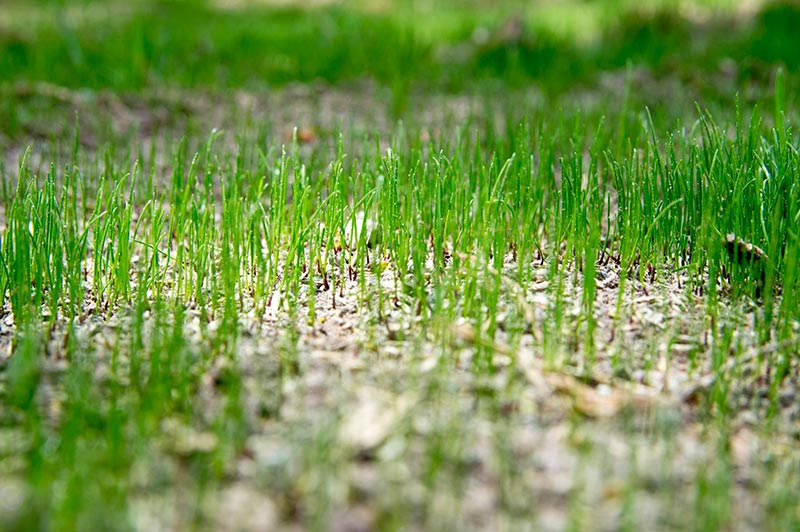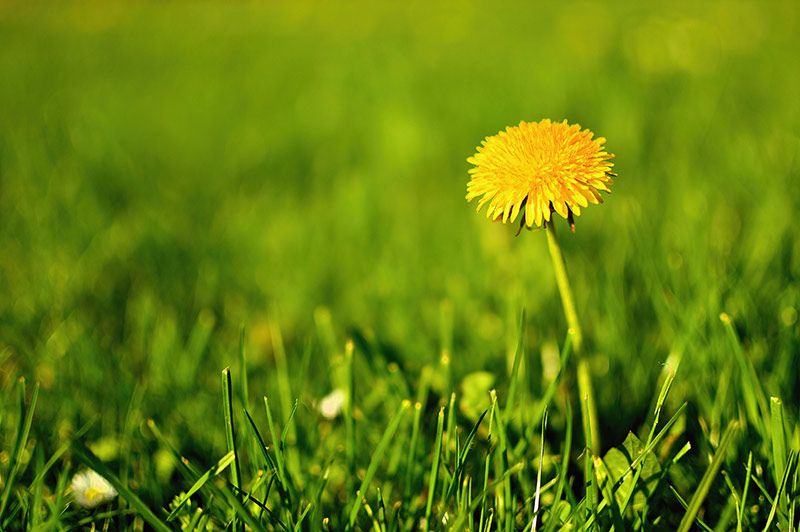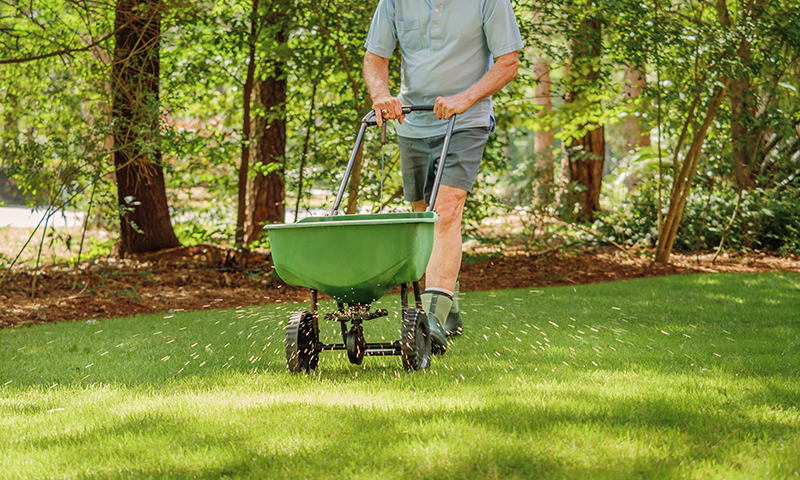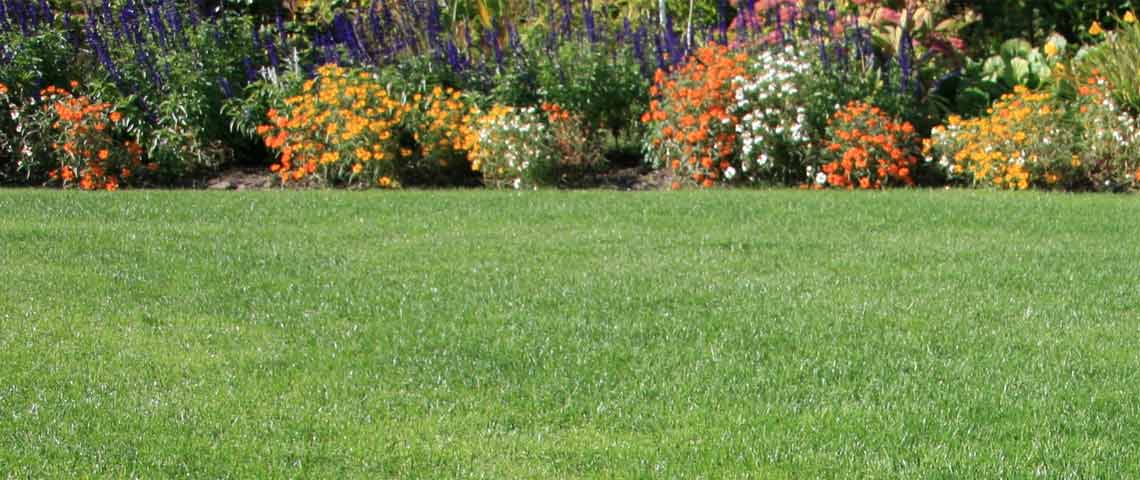When and How to Fertilize Your Lawn
Lawns and people aren’t so different. If you want your grass to look and perform its best, a good diet and proper care help a lot. But how often you need to feed your lawn is the big question. Until recently, the answer was hard to remember and even harder to do.
Lucky for you, we have an answer you're going to like. Instead of painstaking applications of multiple products that drain your budget and your time, you can trim that down to once a season with the Pennington Full Season approach instead.
Ready for lush, thick, green grass with just one application a season? Knowing what to do and when to do it starts here.
- When and How to Fertilize New Grass
- When and How to Fertilize Established Lawns
- How to Apply Lawn Fertilizer for Best Results

Feeding your new lawn helps seed or sod get started right.
When and How to Fertilize New Grass
If you're starting a new lawn from seed, plugs or sod — or you're doing bare lawn spot repair — fertilizer helps your grass get the perfect start.
That’s one of the reasons you’ll find fertilizer already in our eco-conscious Pennington Smart Seed mixes and Pennington Smart Patch bare spot repair products. It makes it easy for you and easy for your new grass seed to get just the right amount of fertilizer it needs.
Show your future lawn some love and follow guidelines for the best time to plant grass seed for your region and grass type. Then feed accordingly.
For new lawns started from seed or plugs, apply fertilizer with a regular lawn spreader before you plant, unless fertilizer’s already in your seed mix. If you're starting a lawn with sod, fertilize after your sod is in place.
With Pennington Full Season Lawn Fertilizer 32-0-5, it’s just one application in spring or early fall, and you’re done for a season. That goes for all grass types. Not only will this product feed your new grass up to four months, it also revitalizes your soil with natural beneficial microorganisms that help your lawn thrive.
With any new lawn area, stay away from any weed control products, including crabgrass preventer fertilizers or weed & feed fertilizers, for at least a month before you plant.
After seeding, skip any weed control until your new grass gets established and you mow your lawn at least three times. Any earlier and you might injure your new grass.

Weed & feed fertilizers kill tough weeds and feed your lawn.
When and How to Fertilize Established Lawns
For established northern or southern lawns, Pennington Full Season lawn fertilizers make it simple to keep your grass looking good all season long — and manage nasty weeds when you need it.
Not all weed & feed products can be used on all lawn grasses, so always read the label and make sure your grass is listed for any product you use — before you apply it!
Early to Late Spring Lawns
For northern lawns, spring is prime time for heavy grass growth. When growth peaks, your lawn needs food. If weeds aren’t a problem for you — or you love the look and easy care of a clover lawn — stick with Pennington Full Season Lawn Fertilizer 32-0-5. You’ll give your grass the food it needs to support heavy spring growth and deep greening, but without any weed control.
Where weeds are a problem, warm spring temperatures trigger germination of weed seeds in your lawn. But with the Pennington Full Season line, you can prevent new weeds — and feed your grass — with one product and one application.
For northern and transition zone lawns, Pennington Full Season Weed & Feed with Crabgrass Control 25-0-8 stops new weeds before their roots get established and kills existing listed weeds — all while it feeds your grass up to four months. When existing weeds kick into high gear in late spring, you’re already covered for weed control.
For southern grasses, including Centipedegrass, St. Augustinegrass, and common and hybrid Bermudagrass, Pennington Full Season Southern Weed & Feed 25-0-14 helps green up your lawn, feeds your grass for up to four months, and kills dandelions, dollarweed and more than 100 other listed lawn weeds (and clover). Just one application and you’re done for a season here, too.
Early to Mid-Summer Lawns
During summer months, heat and drought can be tough on lawns. Well-fed grass is more resilient against summer stress. With Pennington Full Season fertilizers applied in spring, your grass is ready for what summer holds.
Whether you use Pennington Full Season Lawn Fertilizer 32-0-5, Pennington Full Season Weed & Feed with Crabgrass Control 25-0-8, or Pennington Full Season Southern Weed & Feed 25-0-14, the fertilizer keeps feeding your lawn so you don't need to fertilize again in summer heat.
While you’re relaxing and enjoying thick, lush green grass, your lawn is getting essential nutrients. So instead of fertilizing and weed control, you can spend your time on other things, like kicking up your feet and sharing your yard with family and friends.

As the season ends, fertilizer helps your grass get ready for winter and spring
Late Summer to Late Fall Lawns
As fall approaches, your grass slows down and starts prepping for winter. But that’s also when broadleaf weeds burst into active growth again. Depending on when you fed your lawn in spring and growing conditions, the fertilizers that kept your lawn nourished for four months may need replenished, too.
If you plan on overseeding in fall, or you don’t have lawn weeds, skip weed control products and stick with Pennington Full Season Lawn Fertilizer 32-0-5. You’ll help supply your grass with nutrients it needs for its winter prep and rapid green-up when spring rolls around again.
For fall weed control, Pennington Full Season Weed & Feed with Crabgrass Control 25-0-8 or Pennington Full Season Southern Weed & Feed 25-0-14 takes care of young weeds and nourishes your lawn for winter resilience and vibrant green growth come spring.
While late summer is a great time to feed your lawn and kill young fall weeds, don’t wait too late. As a general rule, allow six to eight weeks between fertilizing and your first expected frost. Otherwise, tender grass growth may not have time to harden off before winter arrives.
If you don’t know when frost normally hits your region in fall, do a quick search for “first fall frost” and your zip code, and you’ll know. Keep that date in mind for your fall lawn and for late-season veggie harvests, too.

If excess fertilizer gets on sidewalks or patios, sweep it back into grass where it belongs.
How to Apply Lawn Fertilizer for Best Results
Whenever you apply fertilizer, always follow best practices for using fertilizers around pets, children and adults. For best results, mow your lawn one to two days beforehand. Then set your spreader to the setting recommended on the product label.
- For drop spreaders, start with two strips across your lawn's ends. Then work back and forth, overlapping each pass slightly.
- For broadcast spreaders, start on the outside and work in, overlapping slightly as you go.
Remember: Always shut the hopper when you stop and turn to prevent a fertilizer pile. When you're done, sweep any excess fertilizer off hard surfaces, like sidewalks and driveways, and back onto your grass. This prevents iron stains and helps protect the environment against fertilizer runoff.
From now on out, it's easy to remember how often you should fertilize your grass: once a season, when you let Pennington Full Season lawn fertilizers lend a hand.
At Pennington, we’ve been making lawn care simpler, easier and better for generations of lawn lovers. Have more questions? Reach out to us. We have the answers you need.
Always read product labels thoroughly and follow instructions, including specific guidance for your grass type.





